Related Research Articles
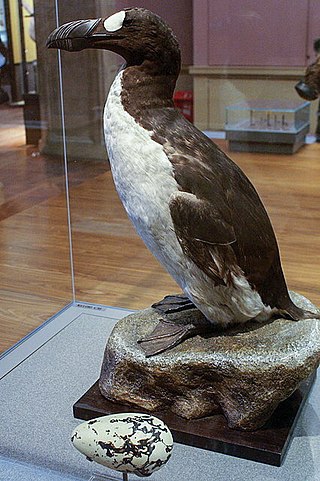
The great auk is a species of flightless alcid that became extinct in the mid-19th century. It was the only modern species in the genus Pinguinus. It is not closely related to the Southern Hemisphere birds now known as penguins, which were discovered later by Europeans and so named by sailors because of their physical resemblance to the great auk, which were called penguins.

Knud Johan Victor Rasmussen was a Greenlandic-Danish polar explorer and anthropologist. He has been called the "father of Eskimology" and was the first European to cross the Northwest Passage via dog sled. He remains well known in Greenland, Denmark and among Canadian Inuit.

Auks or alcids are a group of birds of the family Alcidae in the order Charadriiformes. The alcid family includes the murres, guillemots, auklets, puffins, and murrelets. The family contains 25 extant or recently extinct species that are divided into 11 genera. Auks are found throughout the Northern Hemisphere.

The common eider, also called St. Cuthbert's duck or Cuddy's duck, is a large sea-duck that is distributed over the northern coasts of Europe, North America and eastern Siberia. It breeds in Arctic and some northern temperate regions, but winters somewhat farther south in temperate zones, when it can form large flocks on coastal waters. It can fly at speeds up to 113 km/h (70 mph).
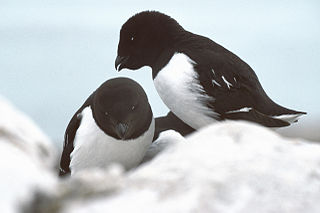
The little auk or dovekie is a small auk, the only member of the genus Alle. Alle is the Sami name of the long-tailed duck; it is onomatopoeic and imitates the call of the drake duck. Linnaeus was not particularly familiar with the winter plumages of either the auk or the duck, and appears to have confused the two species. Other common names include rotch, rotche, bullbird, and sea dove, although the latter sometimes refers to a relative of dovekies, the black guillemot.
The culture of Greenland has much in common with Greenlandic Inuit tradition, as the majority of people are descended from Inuit. Many people still go ice fishing and there are annual dog-sled races in which everyone with a team participates.

Scoresby Sound is a large fjord system of the Greenland Sea on the eastern coast of Greenland. It has a tree-like structure, with a main body approximately 110 km (68 mi) long that branches into a system of fjords covering an area of about 38,000 km2 (14,700 sq mi). The longest of the fjords extends 340–350 km (210-216 mi) inland from the coastline. The depth is 400–600 m (1,310-1,970 ft) in the main basin, but depths increase to up to 1,450 m (4,760 ft) in some fjords. It is one of the largest and longest fjord systems in the world.
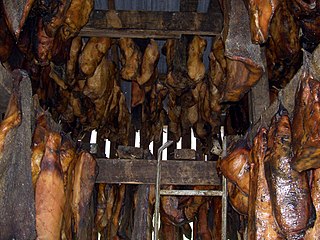
Hákarl, referred to as fermented shark in English, is a national dish of Iceland consisting of Greenland shark or other sleeper shark that has been cured with a particular fermentation process and hung to dry for four to five months. It has a strong ammonia-rich smell and fishy taste, making hákarl an acquired taste.

Nanortalik, formerly Nennortalik, is a town in Nanortalik Island, Kujalleq municipality, southern Greenland. With 1,185 inhabitants as of 2020, it is the eleventh-largest town in the country. The name Nanortalik means "Place of Polar Bears" or "Place Where the Polar Bears Go". It is the southernmost town in Greenland with a population of over 1,000.
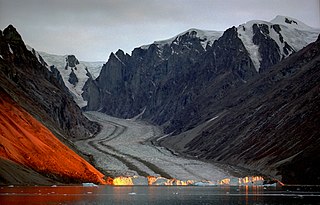
Northeast Greenland National Park is the world's largest national park and the 10th largest protected area. Established in 1974, the Northeast Greenland national park expanded to its present size in 1988. It protects 972,000 km2 (375,000 sq mi) of the interior and northeastern coast of Greenland and is larger than the area of Tanzania, but smaller than that of Egypt. This means that the national park is bigger than 166 of the world's 195 countries. It was the first national park to be created in the Kingdom of Denmark and remains Greenland's only national park. It is the northernmost national park in the world and the second-largest by area of any second-level subdivision of any country in the world, trailing only the Qikiqtaaluk Region in Nunavut, Canada.

Inuit are a group of culturally and historically similar Indigenous peoples traditionally inhabiting the Arctic and subarctic regions of North America, including Greenland, Labrador, Quebec, Nunavut, the Northwest Territories, Yukon (traditionally), Alaska, and Chukotsky District of Chukotka Autonomous Okrug, Russia. Inuit languages are part of the Eskimo–Aleut languages, also known as Inuit-Yupik-Unangan, and also as Eskaleut. Inuit Sign Language is a critically endangered language isolate used in Nunavut.
Although the bulk of its area is covered by ice caps inhospitable to most forms of life, Greenland's terrain and waters support a wide variety of plant and animal species. The northeastern part of the island is the world's largest national park. The flora and fauna of Greenland are strongly susceptible to changes associated with climate change.

Historically, Inuit cuisine, which is taken here to include Greenlandic, Yupʼik and Aleut cuisine, consisted of a diet of animal source foods that were fished, hunted, and gathered locally.

Greenlandic cuisine is traditionally based on meat from marine mammals, birds, and fish, and normally contains high levels of protein. Since colonization and the arrival of international trade, the cuisine has been increasingly influenced by Danish, British, American and Canadian cuisine. During the summer when the weather is milder, meals are often eaten outdoors.

Surströmming is lightly salted, fermented Baltic Sea herring traditional to Swedish cuisine since at least the 16th century. It is distinct from fried or pickled herring.

Yup'ik cuisine refers to the Inuit and Yup'ik style traditional subsistence food and cuisine of the Yup'ik people from the western and southwestern Alaska. Also known as Cup'ik cuisine for the Chevak Cup'ik dialect speaking Eskimos of Chevak and Cup'ig cuisine for the Nunivak Cup'ig dialect speaking Eskimos of Nunivak Island. This cuisine is traditionally based on meat from fish, birds, sea and land mammals, and normally contains high levels of protein. Subsistence foods are generally considered by many to be nutritionally superior superfoods. Yup’ik diet is different from Alaskan Inupiat, Canadian Inuit, and Greenlandic diets. Fish as food are primary food for Yup'ik Eskimos. Both food and fish called neqa in Yup'ik. Food preparation techniques are fermentation and cooking, also uncooked raw. Cooking methods are baking, roasting, barbecuing, frying, smoking, boiling, and steaming. Food preservation methods are mostly drying and less often frozen. Dried fish is usually eaten with seal oil. The ulu or fan-shaped knife is used for cutting up fish, meat, food, and such.

Urumiit or uruniit is a term used by native Inuit in Greenland and the Canadian High Arctic to refer to the feces of the rock ptarmigan and the willow ptarmigan, which are considered a delicacy in their food cultures. The droppings are collected when they have dried out during the winter months, a time in which food sources are scarce, especially on land, so the pre-digested willow and birch plant matter in ptarmigan scat provides a much needed source of nutrition in a harsh environment. One ptarmigan may defecate as many as 50 times in one spot, so urumiit is very plentiful and easy to gather. The pellet-shaped droppings are generally cooked in rancidified seal fat before eating; sometimes mixed with seal or ptarmigan meat or blood. Historically in some areas, the meat cooked with urumiit is prepared by being pre-chewed by the women of a household. The smell of cooked urumiit in rancid fat has been compared to that of Gorgonzola cheese. It has been cited as a dish which non-Inuit are particularly likely to find disgusting, and as an example of how much taste in food can vary between cultural contexts.

Traditional Inuit clothing is a complex system of cold-weather garments historically made from animal hide and fur, worn by Inuit, a group of culturally related Indigenous peoples inhabiting the Arctic areas of Canada, Greenland, and the United States. The basic outfit consisted of a parka, pants, mittens, inner footwear, and outer boots. The most common sources of hide were caribou, seals, and seabirds, although other animals were used when available. The production of warm, durable clothing was an essential survival skill which was passed down from women to girls, and which could take years to master. Preparation of clothing was an intensive, weeks-long process that occurred on a yearly cycle following established hunting seasons. The creation and use of skin clothing was strongly intertwined with Inuit religious beliefs.

Archaeological evidence indicates that the use of Inuit clothing extends far back into prehistory, with significant evidence to indicate that its basic structure has changed little since. The clothing systems of all Arctic peoples are similar, and evidence in the form of tools and carved figurines indicates that these systems may have originated in Siberia as early as 22,000 BCE, and in northern Canada and Greenland as early as 2500 BCE. Pieces of garments found at archaeological sites, dated to approximately 1000 to 1600 CE, are very similar to garments from the 17th to mid-20th centuries, which confirms consistency in the construction of Inuit clothing over centuries.
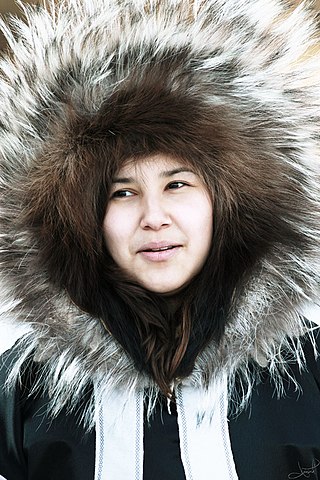
There is a long historical tradition of research on Inuit clothing across many fields. Since Europeans first made contact with the Inuit in the 16th century, documentation and research on Inuit clothing has included artistic depictions, academic writing, studies of effectiveness, and museum collections. Historically, European images of Inuit were sourced from the clothing worn by Inuit who travelled to Europe, clothing brought to museums by explorers, and from written accounts of travels to the Arctic.
References
- ↑ Hay, Mark (7 March 2023). "Inside Greenland's Misunderstood Winter Delicacy". Atlas Obscura. Retrieved 15 March 2023.
- ↑ "Kivak Season in Greenland 2018". rove.me. 23 May 2018. Retrieved 23 May 2018.
- 1 2 3 "TV review: Human Planet". The Guardian. 27 January 2011. Retrieved 28 January 2011.
- ↑ Freuchen, Dagmar (1960). Peter Freuchen's Adventures in the Arctic. New York: Messner. p. 81.
- ↑ Magazine, Smithsonian. "Eating Narwhal". Smithsonian Magazine. Retrieved 19 October 2022.
- ↑ "Review: This Cold Heaven: Seven Seasons in Greenland by Gretel Ehrlich". the Guardian. 16 February 2002. Retrieved 19 October 2022.
- ↑ "Greenland terducken from hell: the real bird-seal meal". The Fourth Continent. 7 August 2013. Archived from the original on 30 July 2014. Retrieved 15 February 2014.